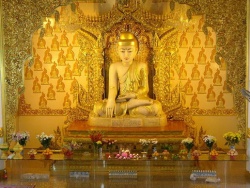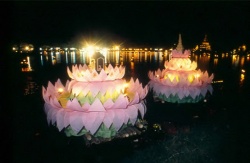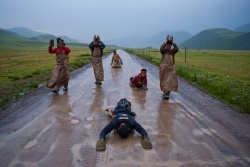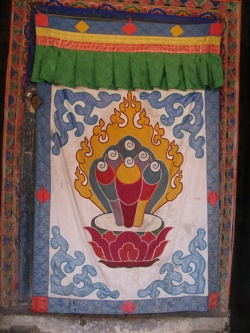Difference between revisions of "Vajrayoginī/Vajravārāhī"
| Line 3: | Line 3: | ||
When [[Jetsun Milarepa]] initiated [[Gambopa]] with urine-flavored tea, he was introducing him to the [[maṇḍala]] of [[Vajravārāhī]]. She is the main [[ḍākinī]] of the [[Kagyud]], [[Mila’s lineage]].2 One of the four great branches of [[Tibetan Buddhism]], it carries the teachings of [[Indian]] [[siddhas]] such as [[Saraha]], [[Tilopa]] and [[Marpa’s]] [[guru]], [[Nāropa]]. [[Ḍākinī]] is a [[word]] with meanings which range from “[[demonic witch]]” to “[[enlightened consort]]”. It is also used as an honorific term for a [[guru’s]] wife. [[Ḍākinīs]] such as [[Vajravārāhī]] are [[female deities]] who represent the [[wisdom]] aspect of [[enlightenment]]. They are [[visualized]], and identified with, in [[meditation]]. | When [[Jetsun Milarepa]] initiated [[Gambopa]] with urine-flavored tea, he was introducing him to the [[maṇḍala]] of [[Vajravārāhī]]. She is the main [[ḍākinī]] of the [[Kagyud]], [[Mila’s lineage]].2 One of the four great branches of [[Tibetan Buddhism]], it carries the teachings of [[Indian]] [[siddhas]] such as [[Saraha]], [[Tilopa]] and [[Marpa’s]] [[guru]], [[Nāropa]]. [[Ḍākinī]] is a [[word]] with meanings which range from “[[demonic witch]]” to “[[enlightened consort]]”. It is also used as an honorific term for a [[guru’s]] wife. [[Ḍākinīs]] such as [[Vajravārāhī]] are [[female deities]] who represent the [[wisdom]] aspect of [[enlightenment]]. They are [[visualized]], and identified with, in [[meditation]]. | ||
| − | As a red [[goddess]], decorated with white ornaments, who also stands on one leg, she should immediately arouse our [[interest]] as possibly [[symbolizing]] the {{Wiki|Amanita muscaria}} mushroom. When we are told that her [[skull-cup]] is “brimming with [[amṛita]]” this only heightens our suspicions. A closer look at her {{Wiki|iconography}} and [[rituals]] reveals abundant references to [[amṛita]] and, covertly, to mushrooms. | + | As a red [[goddess]], decorated with white ornaments, who also stands on one leg, she should immediately arouse our [[interest]] as possibly [[symbolizing]] the {{Wiki|Amanita muscaria}} mushroom. When we are told that her [[skull-cup]] is “brimming with [[amṛita]]” this only heightens our suspicions. A closer look at her {{Wiki|iconography}} and [[rituals]] reveals abundant references to [[amṛita]] and, covertly, to {{Wiki|mushrooms}}. |
[[Vajrayoginī]] (“[[Thunderbolt Yoga-lady]]”) is, in many ways, the {{Wiki|archetypal}} [[ḍākinī]]. She is almost completely interchangeable with [[Vajravārāhī]] (“[[Thunderbolt Sow]]”), being [[identical]] in every regard except for a single iconographic detail: [[Vajravārāhī]] has a small excrescence in the shape of a sow’s head above her right {{Wiki|ear}}. The prefix [[Vajra]]- serves to distinguish [[Vajravārāhī]] from the [[Hindu]] [[goddess]] [[Vārāhī]] (“Sow”), [[consort]] of [[Vārāha]], the “{{Wiki|boar}} [[incarnation]]” of [[Viṣṇu]]. Thus, [[Vajra-vārāhī]] is “the Sow [[goddess]] of the [[Vajrayāna]]” or “[[Buddhist]] [[Vārāhī]].” | [[Vajrayoginī]] (“[[Thunderbolt Yoga-lady]]”) is, in many ways, the {{Wiki|archetypal}} [[ḍākinī]]. She is almost completely interchangeable with [[Vajravārāhī]] (“[[Thunderbolt Sow]]”), being [[identical]] in every regard except for a single iconographic detail: [[Vajravārāhī]] has a small excrescence in the shape of a sow’s head above her right {{Wiki|ear}}. The prefix [[Vajra]]- serves to distinguish [[Vajravārāhī]] from the [[Hindu]] [[goddess]] [[Vārāhī]] (“Sow”), [[consort]] of [[Vārāha]], the “{{Wiki|boar}} [[incarnation]]” of [[Viṣṇu]]. Thus, [[Vajra-vārāhī]] is “the Sow [[goddess]] of the [[Vajrayāna]]” or “[[Buddhist]] [[Vārāhī]].” | ||
| − | In the “[[Wheel of Life]]” (Skt., [[bhavacakra]]), a diagram said to have its origin in [[Buddhism’s]] earliest period, the [[pig]] [[symbolizes]] [[ignorance]]. This is because pigs eat whatever is in front of them without {{Wiki|discrimination}}. The [[Vajrayāna]] makes the same observation about porcine table manners but, in a [[characteristic]] inversion of [[symbolic]] values, asserts that the sow’s head [[symbolizes]] a [[meditative]] state known as “one {{Wiki|taste}}” (Skt., [[ekarasa]]). On a more [[mundane]] level, we should not overlook the fact that pigs are notoriously fond of mushrooms nor that the [[vajra]], [[Indra’s]] [[thunderbolt]] weapon, features in several {{Wiki|legends}} of the origin of [[soma]]. | + | In the “[[Wheel of Life]]” (Skt., [[bhavacakra]]), a diagram said to have its origin in [[Buddhism’s]] earliest period, the [[pig]] [[symbolizes]] [[ignorance]]. This is because pigs eat whatever is in front of them without {{Wiki|discrimination}}. The [[Vajrayāna]] makes the same observation about porcine table manners but, in a [[characteristic]] inversion of [[symbolic]] values, asserts that the sow’s head [[symbolizes]] a [[meditative]] state known as “one {{Wiki|taste}}” (Skt., [[ekarasa]]). On a more [[mundane]] level, we should not overlook the fact that pigs are notoriously fond of {{Wiki|mushrooms}} nor that the [[vajra]], [[Indra’s]] [[thunderbolt]] weapon, features in several {{Wiki|legends}} of the origin of [[soma]]. |
In addition to their iconographic similarities, [[Vajrayoginī]] and [[Vajravārāhī]] are interchangeable in that they are both considered to be the [[consort]] of the [[heruka Cakrasaṃvara]]. Despite their [[wrathful]] [[appearance]], [[herukas]] represent the [[compassion]] aspect of [[enlightenment]]. [[Transcendent wisdom]], its complementary aspect, is represented by their {{Wiki|female}} [[consorts]], in this case [[Vajrayoginī]]. | In addition to their iconographic similarities, [[Vajrayoginī]] and [[Vajravārāhī]] are interchangeable in that they are both considered to be the [[consort]] of the [[heruka Cakrasaṃvara]]. Despite their [[wrathful]] [[appearance]], [[herukas]] represent the [[compassion]] aspect of [[enlightenment]]. [[Transcendent wisdom]], its complementary aspect, is represented by their {{Wiki|female}} [[consorts]], in this case [[Vajrayoginī]]. | ||
| − | [[Cakra-saṃvara]] means “[[wheel-saṃvara]]”. {{Wiki|Vedic}} texts mention [[Samvara]] as the [[name]] of a drought-demon (drought is inimical to moisture-loving mushrooms) while a much later [[tradition]] has [[Samvara]] as a {{Wiki|synonym}} of [[Śiva]]. In [[Buddhism]], [[Samvara]] (or [[Sambara]]) is a variant [[form]] of the [[meditation-deity]] [[Hevajra]]. But, when used as a common {{Wiki|noun}}, [[saṃvara]] is also a {{Wiki|synonym}} for [[samaya]], a [[word]] with two meanings: “[[vow]]” and “sacrament”. [[Jayabhadra]], in his commentary on the [[Laghu-śaṃvarai]] states that the initiate is: | + | [[Cakra-saṃvara]] means “[[wheel-saṃvara]]”. {{Wiki|Vedic}} texts mention [[Samvara]] as the [[name]] of a drought-demon (drought is inimical to moisture-loving {{Wiki|mushrooms}}) while a much later [[tradition]] has [[Samvara]] as a {{Wiki|synonym}} of [[Śiva]]. In [[Buddhism]], [[Samvara]] (or [[Sambara]]) is a variant [[form]] of the [[meditation-deity]] [[Hevajra]]. But, when used as a common {{Wiki|noun}}, [[saṃvara]] is also a {{Wiki|synonym}} for [[samaya]], a [[word]] with two meanings: “[[vow]]” and “sacrament”. [[Jayabhadra]], in his commentary on the [[Laghu-śaṃvarai]] states that the initiate is: |
…committed to the [[saṃvara]], both those to be observed and those to be consumed. 3 | …committed to the [[saṃvara]], both those to be observed and those to be consumed. 3 | ||
| − | In other words, [[saṃvara]] means both the [[amṛita]] consumed at the outset of the [[initiation]] and the [[vows]] made at its conclusion. Thus, the [[name]] [[Cakrasaṃvara]] may be translated as “[[wheel-sacrament]]”. In an earlier chapter we examined the [[wheel]] as a mushroom [[symbol]] and therefore the interpretation of [[Cakrasaṃvara]] as “[[mushroom-sacrament]]” remains a {{Wiki|distinct}} possibility. | + | In other words, [[saṃvara]] means both the [[amṛita]] consumed at the outset of the [[initiation]] and the [[vows]] made at its conclusion. Thus, the [[name]] [[Cakrasaṃvara]] may be translated as “[[wheel-sacrament]]”. In an earlier [[chapter]] we examined the [[wheel]] as a mushroom [[symbol]] and therefore the interpretation of [[Cakrasaṃvara]] as “[[mushroom-sacrament]]” remains a {{Wiki|distinct}} possibility. |
The [[Cakrasaṃvara tāntra]] describes the {{Wiki|sexual}} union of [[Vajrayoginī]] and [[Cakrasaṃvara]] though, as with all [[tāntras]], this is intended to be understood on many levels. The interpretations range from {{Wiki|subtle}} [[yogas]] of [[bodily]] energies to teachings on the {{Wiki|inseparability}} of [[voidness]] and [[bliss]]. [[Heruka]] and [[Vajrayoginī]] are considered to be fully {{Wiki|equivalent}} to other such pairs such as [[Hevajra]] and [[Nairatmya]] in the [[Hevajra tāntra]]. These [[deity]] pairs were (and still are) [[visualized]] in the [[meditation practices]] of [[tantric]] [[Buddhists]] but in the [[Kagyud]] [[tradition]] it is most often [[Vajrayoginī]] (or her close [[relation]] [[Vajravārāhī]]) alone who is the main [[object]] of [[meditation]]. | The [[Cakrasaṃvara tāntra]] describes the {{Wiki|sexual}} union of [[Vajrayoginī]] and [[Cakrasaṃvara]] though, as with all [[tāntras]], this is intended to be understood on many levels. The interpretations range from {{Wiki|subtle}} [[yogas]] of [[bodily]] energies to teachings on the {{Wiki|inseparability}} of [[voidness]] and [[bliss]]. [[Heruka]] and [[Vajrayoginī]] are considered to be fully {{Wiki|equivalent}} to other such pairs such as [[Hevajra]] and [[Nairatmya]] in the [[Hevajra tāntra]]. These [[deity]] pairs were (and still are) [[visualized]] in the [[meditation practices]] of [[tantric]] [[Buddhists]] but in the [[Kagyud]] [[tradition]] it is most often [[Vajrayoginī]] (or her close [[relation]] [[Vajravārāhī]]) alone who is the main [[object]] of [[meditation]]. | ||
| Line 23: | Line 23: | ||
In all her variants except one, the [[ḍākinī]] [[Vajrayoginī]] carries a [[skull-cup]] (of {{Wiki|blood}} or [[amṛita]]) and in many [[forms]] she drinks from it. The exception is her headless [[form]] in which she has cut off her own head with her [[kartri]], and holds her own head in her left hand where normally she would hold the [[skull-cup]]. Three streams of {{Wiki|blood}} arc upwards from her neck, the central one falling into the {{Wiki|mouth}} of her own, [[severed head]] and the left and right streams fall into the open mouths of her two attendant [[ḍākinīs]]. | In all her variants except one, the [[ḍākinī]] [[Vajrayoginī]] carries a [[skull-cup]] (of {{Wiki|blood}} or [[amṛita]]) and in many [[forms]] she drinks from it. The exception is her headless [[form]] in which she has cut off her own head with her [[kartri]], and holds her own head in her left hand where normally she would hold the [[skull-cup]]. Three streams of {{Wiki|blood}} arc upwards from her neck, the central one falling into the {{Wiki|mouth}} of her own, [[severed head]] and the left and right streams fall into the open mouths of her two attendant [[ḍākinīs]]. | ||
| − | Generally, we are told that the “{{Wiki|blood}}” which [[Vajrayoginī]] drinks is the “{{Wiki|blood}} of the enemies” but the {{Wiki|invocation}} of the headless [[form]] shows that it is her own [[essence]] which is being consumed. Her descriptions may be read on at least two levels, literal and {{Wiki|metaphorical}}. I believe that both were intended. The literal one is as a young {{Wiki|female}} [[yogi]], drinking a reddish liquid from a [[human]] [[skull-cup]] by the light of the [[funeral]] pyres of a [[cremation ground]]. To take that as the only interpretation leaves several [[elements]] unexplained, however. | + | Generally, we are told that the “{{Wiki|blood}}” which [[Vajrayoginī]] drinks is the “{{Wiki|blood}} of the enemies” but the {{Wiki|invocation}} of the headless [[form]] shows that it is her own [[essence]] which is being consumed. Her descriptions may be read on at least two levels, literal and {{Wiki|metaphorical}}. I believe that both were intended. The literal one is as a young {{Wiki|female}} [[yogi]], drinking a reddish liquid from a [[human]] [[skull-cup]] by the {{Wiki|light}} of the [[funeral]] pyres of a [[cremation ground]]. To take that as the only interpretation leaves several [[elements]] unexplained, however. |
How big is a {{Wiki|skull}}? | How big is a {{Wiki|skull}}? | ||
| − | [[Buddhist]] images display a {{Wiki|distinct}} double standard when it comes to skulls. The skull-cups which hold [[amṛita]] or other liquids are always life-size. That is, their size is comparable to the head of the [[deity]] holding it. Then there are the other, ornamental, skulls and heads which are much smaller. The skulls adorning [[Vajrayoginī’s]] tiara, the “[[human]] heads” which hang as a garland around her neck and those impaled upon her [[khaṭvāṅga]] [[staff]] cannot possibly be of normal size. The notion of someone wearing five [[human]] skulls as {{Wiki|crown}} ornaments and fifty heads as a necklace is as implausible as it is grotesque. But nowhere in the descriptions of the many [[deities]] who wear such heads and skulls is it stated that they are anything less than normal size. | + | [[Buddhist]] images display a {{Wiki|distinct}} double standard when it comes to skulls. The skull-cups which hold [[amṛita]] or other liquids are always life-size. That is, their size is comparable to the head of the [[deity]] holding it. Then there are the other, ornamental, skulls and heads which are much smaller. The skulls adorning [[Vajrayoginī’s]] [[tiara]], the “[[human]] heads” which hang as a garland around her neck and those impaled upon her [[khaṭvāṅga]] [[staff]] cannot possibly be of normal size. The notion of someone wearing five [[human]] skulls as {{Wiki|crown}} ornaments and fifty heads as a necklace is as implausible as it is grotesque. But nowhere in the descriptions of the many [[deities]] who wear such heads and skulls is it stated that they are anything less than normal size. |
One might [[logically]] infer, then, that as these [[deities]] are [[supernatural]] [[beings]] they must be of superhuman size and the skulls just look small by comparison. However, [[Buddhist]] {{Wiki|artists}} use iconographic texts which preserve the [[Wikipedia:canonical|canonical]] {{Wiki|dimensions}} of the [[deities]]. These diagrams use a system of iconometric grids to give the size and proportions of all [[beings]] who may be painted: [[Buddhas]], [[bodhisattvas]], [[gods]] and even {{Wiki|goblins}}. According to these [[Wikipedia:canonical|canonical]] proportions, [[ḍākinīs]] come in one standard height: [[108]] “[[finger widths]]” (Tib., [[Sor.Tshigs]]) or somewhere around 6ft 6in. This is, admittedly, an imposing height for a sixteen-year-old girl but that is still nowhere near large enough for her to wear five [[human]] skulls on her headband. | One might [[logically]] infer, then, that as these [[deities]] are [[supernatural]] [[beings]] they must be of superhuman size and the skulls just look small by comparison. However, [[Buddhist]] {{Wiki|artists}} use iconographic texts which preserve the [[Wikipedia:canonical|canonical]] {{Wiki|dimensions}} of the [[deities]]. These diagrams use a system of iconometric grids to give the size and proportions of all [[beings]] who may be painted: [[Buddhas]], [[bodhisattvas]], [[gods]] and even {{Wiki|goblins}}. According to these [[Wikipedia:canonical|canonical]] proportions, [[ḍākinīs]] come in one standard height: [[108]] “[[finger widths]]” (Tib., [[Sor.Tshigs]]) or somewhere around 6ft 6in. This is, admittedly, an imposing height for a sixteen-year-old girl but that is still nowhere near large enough for her to wear five [[human]] skulls on her headband. | ||
Latest revision as of 08:09, 19 December 2014
When Jetsun Milarepa initiated Gambopa with urine-flavored tea, he was introducing him to the maṇḍala of Vajravārāhī. She is the main ḍākinī of the Kagyud, Mila’s lineage.2 One of the four great branches of Tibetan Buddhism, it carries the teachings of Indian siddhas such as Saraha, Tilopa and Marpa’s guru, Nāropa. Ḍākinī is a word with meanings which range from “demonic witch” to “enlightened consort”. It is also used as an honorific term for a guru’s wife. Ḍākinīs such as Vajravārāhī are female deities who represent the wisdom aspect of enlightenment. They are visualized, and identified with, in meditation.
As a red goddess, decorated with white ornaments, who also stands on one leg, she should immediately arouse our interest as possibly symbolizing the Amanita muscaria mushroom. When we are told that her skull-cup is “brimming with amṛita” this only heightens our suspicions. A closer look at her iconography and rituals reveals abundant references to amṛita and, covertly, to mushrooms.
Vajrayoginī (“Thunderbolt Yoga-lady”) is, in many ways, the archetypal ḍākinī. She is almost completely interchangeable with Vajravārāhī (“Thunderbolt Sow”), being identical in every regard except for a single iconographic detail: Vajravārāhī has a small excrescence in the shape of a sow’s head above her right ear. The prefix Vajra- serves to distinguish Vajravārāhī from the Hindu goddess Vārāhī (“Sow”), consort of Vārāha, the “boar incarnation” of Viṣṇu. Thus, Vajra-vārāhī is “the Sow goddess of the Vajrayāna” or “Buddhist Vārāhī.”
In the “Wheel of Life” (Skt., bhavacakra), a diagram said to have its origin in Buddhism’s earliest period, the pig symbolizes ignorance. This is because pigs eat whatever is in front of them without discrimination. The Vajrayāna makes the same observation about porcine table manners but, in a characteristic inversion of symbolic values, asserts that the sow’s head symbolizes a meditative state known as “one taste” (Skt., ekarasa). On a more mundane level, we should not overlook the fact that pigs are notoriously fond of mushrooms nor that the vajra, Indra’s thunderbolt weapon, features in several legends of the origin of soma.
In addition to their iconographic similarities, Vajrayoginī and Vajravārāhī are interchangeable in that they are both considered to be the consort of the heruka Cakrasaṃvara. Despite their wrathful appearance, herukas represent the compassion aspect of enlightenment. Transcendent wisdom, its complementary aspect, is represented by their female consorts, in this case Vajrayoginī.
Cakra-saṃvara means “wheel-saṃvara”. Vedic texts mention Samvara as the name of a drought-demon (drought is inimical to moisture-loving mushrooms) while a much later tradition has Samvara as a synonym of Śiva. In Buddhism, Samvara (or Sambara) is a variant form of the meditation-deity Hevajra. But, when used as a common noun, saṃvara is also a synonym for samaya, a word with two meanings: “vow” and “sacrament”. Jayabhadra, in his commentary on the Laghu-śaṃvarai states that the initiate is:
…committed to the saṃvara, both those to be observed and those to be consumed. 3
In other words, saṃvara means both the amṛita consumed at the outset of the initiation and the vows made at its conclusion. Thus, the name Cakrasaṃvara may be translated as “wheel-sacrament”. In an earlier chapter we examined the wheel as a mushroom symbol and therefore the interpretation of Cakrasaṃvara as “mushroom-sacrament” remains a distinct possibility.
The Cakrasaṃvara tāntra describes the sexual union of Vajrayoginī and Cakrasaṃvara though, as with all tāntras, this is intended to be understood on many levels. The interpretations range from subtle yogas of bodily energies to teachings on the inseparability of voidness and bliss. Heruka and Vajrayoginī are considered to be fully equivalent to other such pairs such as Hevajra and Nairatmya in the Hevajra tāntra. These deity pairs were (and still are) visualized in the meditation practices of tantric Buddhists but in the Kagyud tradition it is most often Vajrayoginī (or her close relation Vajravārāhī) alone who is the main object of meditation.
Although many variants of Vajrayoginī are known, almost all forms show her as a naked sixteen-year-old girl, bright red, and adorned with white beads made of human bone. She carries a skull cup full of blood in her left hand, a curious staff (Skt., khaṭvāṅga) in the crook of her left arm and a “cutter” (Skt., kartṛi), a kind of curved knife, in her right hand.
In all her variants except one, the ḍākinī Vajrayoginī carries a skull-cup (of blood or amṛita) and in many forms she drinks from it. The exception is her headless form in which she has cut off her own head with her kartri, and holds her own head in her left hand where normally she would hold the skull-cup. Three streams of blood arc upwards from her neck, the central one falling into the mouth of her own, severed head and the left and right streams fall into the open mouths of her two attendant ḍākinīs.
Generally, we are told that the “blood” which Vajrayoginī drinks is the “blood of the enemies” but the invocation of the headless form shows that it is her own essence which is being consumed. Her descriptions may be read on at least two levels, literal and metaphorical. I believe that both were intended. The literal one is as a young female yogi, drinking a reddish liquid from a human skull-cup by the light of the funeral pyres of a cremation ground. To take that as the only interpretation leaves several elements unexplained, however.
How big is a skull?
Buddhist images display a distinct double standard when it comes to skulls. The skull-cups which hold amṛita or other liquids are always life-size. That is, their size is comparable to the head of the deity holding it. Then there are the other, ornamental, skulls and heads which are much smaller. The skulls adorning Vajrayoginī’s tiara, the “human heads” which hang as a garland around her neck and those impaled upon her khaṭvāṅga staff cannot possibly be of normal size. The notion of someone wearing five human skulls as crown ornaments and fifty heads as a necklace is as implausible as it is grotesque. But nowhere in the descriptions of the many deities who wear such heads and skulls is it stated that they are anything less than normal size.
One might logically infer, then, that as these deities are supernatural beings they must be of superhuman size and the skulls just look small by comparison. However, Buddhist artists use iconographic texts which preserve the canonical dimensions of the deities. These diagrams use a system of iconometric grids to give the size and proportions of all beings who may be painted: Buddhas, bodhisattvas, gods and even goblins. According to these canonical proportions, ḍākinīs come in one standard height: 108 “finger widths” (Tib., Sor.Tshigs) or somewhere around 6ft 6in. This is, admittedly, an imposing height for a sixteen-year-old girl but that is still nowhere near large enough for her to wear five human skulls on her headband.
The grids are extremely useful for determining the intended size of her skull ornaments. Measurements with the grids show that these “skulls” are between three and four inches across. This is far too small for even a child’s head but it is just about right for the dried “head” (i.e. cap) of an Amanita muscaria mushroom.



